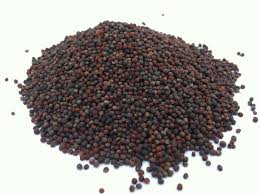
Some whole foods consumers have expressed concern about the use of canola oil for a few years. Much of this concern, however, is due to confusion and misunderstanding on how canola oil is made and what it is actually made from.
There are numerous articles shared on the internet that are aiming at explaining the “truth”, but end up pulling information that is either misinformed, related only to conventional canola oil, or based on information from decades past when organic and non-GMO oils were not so readily available.
Unfortunately, when it comes to the internet it’s hard to know what is correct. So I’d like to address a few myths and truths related to Organic Canola Oil with answers directly from the source.
Myth #1: Organic Canola Oil is produced using solvents like hexane.
 Organic Canola Oil is produced through a mechanical expeller-pressed method (where the oil is literally squeezed out of the seed), so solvents and hexane are not used and are not present.
Organic Canola Oil is produced through a mechanical expeller-pressed method (where the oil is literally squeezed out of the seed), so solvents and hexane are not used and are not present.
Manufacturers of any organically certified dietary oil are banned by USDA National Organic Program law from using solvents for extraction, therefore you can have full confidence that NONE of the certified organic plant- and fruit-based oils are allowed to use solvents for extraction.
This oil is usually refined using a vacuum, heat and organic approved earthen clay, though cold-pressed and unrefined versions are available.
This myth comes from the fact that most RBD canola oil that's not organic (and also not expeller pressed) IS, in fact, solvent expelled. At least 90% of the canola oil on the market today is this solvent expelled oil, and as a result, this is often misapplied to organic canola as well. But the organic canola oil is not solvent expelled.
Myth #2: The original canola plant was known as rapeseed, and was genetically modified to become a canola plant, and therefore organic canola oil inherently cannot be non-GMO.
 When first produced, canola oil originally was bred from a plant known as Rapeseed (Brassica napus L.). Rapeseed has a high level of erucic acid and is not safe for consumption.
When first produced, canola oil originally was bred from a plant known as Rapeseed (Brassica napus L.). Rapeseed has a high level of erucic acid and is not safe for consumption.
The plants now used to make canola oil are from a different variety, known as canola plants, that have a much lower level of erucic acid. These canola plants are the result of the hybridization the rapeseed plant. Some varieties of canola are hybrid and some are open pollinated; both of these are the result of traditional breeding, not genetic engineering.
The truth-finding website Snopes discusses these historical developments in canola breeding in more detail:
“In 1974, rapeseed varieties with a low erucic content were introduced. Scientists had found a way to replace almost all of rapeseed’s erucic acid with oleic acid, a type of monounsaturated fatty acid. (This change was accomplished through the cross-breeding of plants, not by the techniques commonly referred to as “genetic engineering.”) By 1978, all Canadian rapeseed produced for food use contained less than 2% erucic acid. The Canadian seed oil industry rechristened the product “canola oil” (Canadian oil) in 1978 in an attempt to distance the product from negative associations with the word “rape.” Canola was introduced to American consumers in 1986. By 1990, erucic acid levels in canola oil ranged from 0.5% to 1.0%, in compliance with U.S. Food and Drug Administration (FDA) standards.” Source
Genetic engineering came into play many years later as these canola plants were genetically modified to be tolerant to Roundup. This genetic engineering involves splicing genes, and the specific purpose was to make this crop less susceptible to pests and disease.
It’s important to understand that the crops (once known as rapeseed, now known as canola) didn’t morph from one variety to the other using genetic engineering-- that happened through a natural hybridization process. Therefore, it’s not in canola’s “life blood” that it is a genetically engineered oil at it’s foundational level.
Not all canola seeds were genetically modified — there were strains that remained untouched, and those are just the seeds now being used for all of the Non-GMO Project Verified Canola Oil and in Organic Canola Oil (which can not use seeds that have been genetically modified).
The the USDA National Organic Program also outlaws the use of GMOs in any organic products: “The use of GMOs is prohibited in organic production and handling.” You can even read the USDA NOP Organic guidelines here which outlaw GMOs and require programs for GMO avoidance to be in place.
The Non-GMO Project also heavily vets and tests the products that their seal appears on, so if you have wondered how it’s possible that they are verifying organic canola oil, this is how. These particular seeds are, in fact, naturally non-GMO and always have been.
Myth #3: Canola oil is made from GMO seed – even organic canola oil is at risk of containing GMOs due to cross contamination.

Using the reasoning above, not ALL canola is made from GMO seed. There is still a small percentage of seed that is produced without genetic modification, which becomes Non-GMO or Organic Canola Oil. These oils are produced using seed that has never been genetically modified.
That said, when grown next to conventional GMO Canola crops in North America, cross contamination can be a concern. This is why our Organic Canola Oil is Non-GMO Project Verified, to ensure that each batch is genetically tested and no GMO contamination is present.
The Non-GMO Project provides excellent vetting of organic canola sources and requires genetic testing in order to achieve certification.
Myth #4: Canola oil is an invention of the food industry.
The “canola” name is indeed a recent invention of the food industry for marketing purposes since the word “rapeseed” is not as catchy or appealing to the general public. The name Canola actually stands for Canadian Oil Low Acid (CAN-O-L-A) The seed itself is actually a cousin of rapeseed, not exactly the same thing, as it contains less erucic acid and more healthy oleic acid (monounsaturated fats).
However, rapeseed oil has been around for thousands of years in China, India, and Japan as a food source that was always eaten with saturated fat for proper absorption. The primary difference between today’s canola oil and more ancient rapeseed oil is the monounsaturated fat in canola oil is primarily oleic acid (which is also found in olive and hi-oleic sunflower oils) instead of the erucic acid that is high in rapeseed.
So the food industry didn’t invent the plant and the oil itself; however, they did create the “canola” name to avoid having a product connected to the word “rape”.
Myth #5: Canola oil is a poisonous substance, an industrial oil that does not belong in the body. It contains ‘the infamous chemical warfare agent mustard gas,’ hemagglutinins and toxic cyanide-containing glycocides; it causes mad cow disease, blindness, nervous disorders, clumping of blood cells and depression of the immune system.
Reports on the dangers of rapeseed oil are rampant on the internet, mostly stemming from an article, “Blindness, Mad Cow Disease and Canola Oil,” by John Thomas, which appeared in Perceptions magazine (March/April 1996) – a non-scientific magazine. Some of the claims are ludicrous. Although rape is a member of the brassica or mustard family, it is not the source of mustard gas used in chemical warfare. Glycosides or glycosinolates (compounds that produce sugars on hydrolysis) are found in most members of the brassica family, including broccoli, kale, cabbage and mustard greens. They contain sulfur (not arsenic), which is what gives mustard and cruciferous vegetables their pungent flavor. These compounds are goitrogenic and are ideally neutralized by cooking or fermentation. As rapeseed meal was high in glycosides, it could not be used in large amounts for animal feeding. However, plant breeders have been able to breed out the glycosides as well as the erucic acid from canola oil. The result is a low-glycoside meal that can be used as an animal feed. In fact, canola meal for animal feed is an important Canadian export. Source
Hemagglutinins, substances that promote blood clotting and depress growth, are found in the protein portion of the seed, which are not present in the oil because all proteins are removed. Canola oil was not the cause of the mad cow epidemic in Britain, although, it is possible feeding cows a diet high in polyunsaturated fats may have made them more susceptible to certain diseases. Source
Like all fats and oils, rapeseed oil has industrial uses. It can be used as an insecticide, a lubricant, a fuel and in soap, synthetic rubber and ink. Like flax oil and walnut oil, it can be used to make varnish. Traditional fats like coconut oil, olive oil and tallow also have industrial uses, but that does not make them dangerous for human consumption.
Want to learn more? Read Canola Oil Myths & Truths by Berkeley Wellness
Topics: Canola Oil












